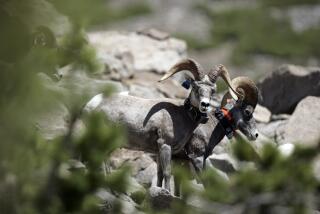Locked horns
Geneticist David Coltman knew his study of rams in the mountains of Alberta, Canada, would yield important information about trophy hunting and horn size among bighorn sheep, but he never expected that his conclusions would create a furor among partisans on both sides of the hunting debate.
Coltman and a team of researchers found that trophy hunting of rams not only removed those majestic specimens from the wild but led to a smaller, frailer sheep herd overall and fewer big rams over the long run.
âUnrestricted harvesting of trophy rams has thus contributed to a decline in the very traits that determine trophy quality,â the study concludes.
Since its publication in December in the journal Nature, animal rights groups have trumpeted the study as proof that hunting is detrimental to wildlife. Hunters and game managers, however, denounce the paper and warn against making too much of the results.
Meanwhile, the authors are surprised by the outcry. They say their intent was to promote discussion about how targeting trophy animals alters natural selection.
âWe wanted to frame the paper with the message that human activity can have an evolutionary impact,â says Coltman, a lecturer at the University of Sheffield in England. âIt may have framed hunting a bit darker than we intended. Nowhere did we suggest that we shouldnât hunt. We should just think about how we do it.â
The scientists examined the horn size of rams in a herd at Ram Mountain in Alberta over 30 years. Each year, a high percentage of the legally available rams are shot, more than is usually taken from a herd during hunts in the United States. Larger rams with fast-growing horns were often shot before they reached prime breeding age, so they didnât get the chance to pass on their genes. As a result, fewer big rams were found in the herd over time, the study shows.
Over three decades, the average horn size of rams remaining in the herd declined by nearly 8 inches, and their weight fell by about 40 pounds. In a domino effect, smaller rams sire slighter ewes, which produce less robust lambs, which results in diminished genetic fitness for the entire herd, the study says.
The findings prove that trophy hunting is not sustainable and is harmful to animal populations, says D.J. Schubert, wildlife biologist for Fund for Animals, an anti-hunting group. He says the article provides âmore ammunition to use in convincing the [wildlife] agencies to grapple with this issue that they donât want to touch.â
But hunting advocates and wildlife officials in the United States say game management policies are sound, and they warn against applying the studyâs findings too broadly. They say few restrictions were in effect for the Ram Mountain sheep hunts, unlike the highly regulated hunts in the U.S.
Ray Lee, president of the Foundation for North American Wild Sheep, a pro-hunting conservation group, says the study does not account for sheep herds in Arizona, where more and more record-size rams are reported. Also, sheep hunters often pay huge sums of money to kill a trophy, and the money is used to promote bighorn herds.
In California, about a dozen of the 3,100 Nelsonâs bighorn sheep have been shot in each of the past five years, fewer than at Ram Mountain and not enough to weaken the herd in the long term, says Mike Wintemute, deputy director of state Department of Fish and Game.
But what really irks game managers is that the study urges scientists to consider evolutionary consequences of sheep hunting. â[It] implies that none of us dumb bunnies have thought about it,â says Eric Rominger, biologist for the New Mexico Department of Fish and Game. âOnly Coltman et al. have thought about it. And that got a lot of peopleâs dander up.â
Coltman says the study is not a critique of managed hunts in the United States. Indeed, he says bighorn herds in Alberta and parts of Asia and the former Soviet Union could benefit from some U.S.-style regulations.
Jon Jorgenson, wildlife biologist for Alberta Sustainable Resource Development and a coauthor of the study, says his agency will review the findings to determine if other sheep populations in the Canadian province suffer similar effects. He says officials might limit hunters, raise license fees or allow hunting of old rams with full-curl horns.
âWe need to examine this across the province before we start making changes,â he said.






